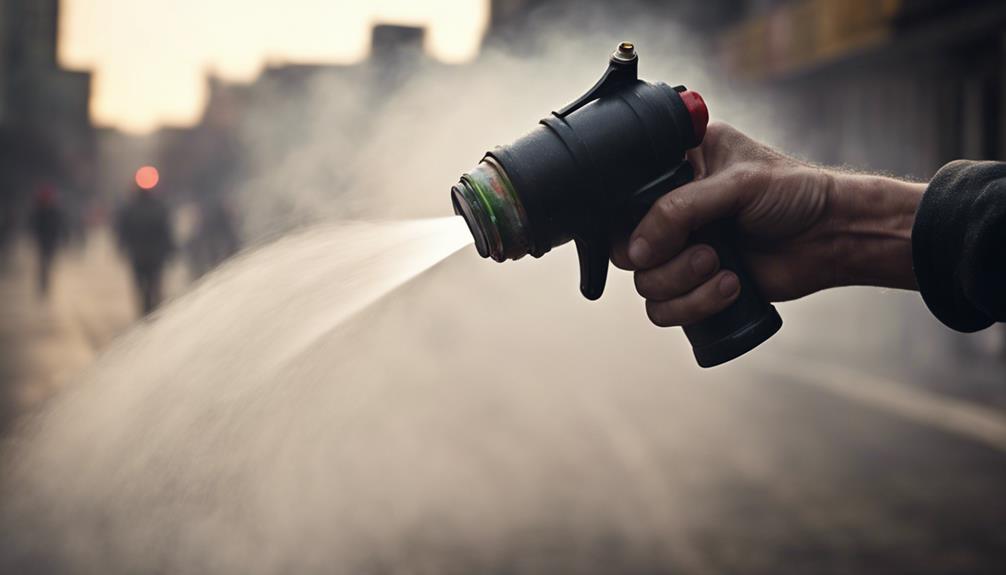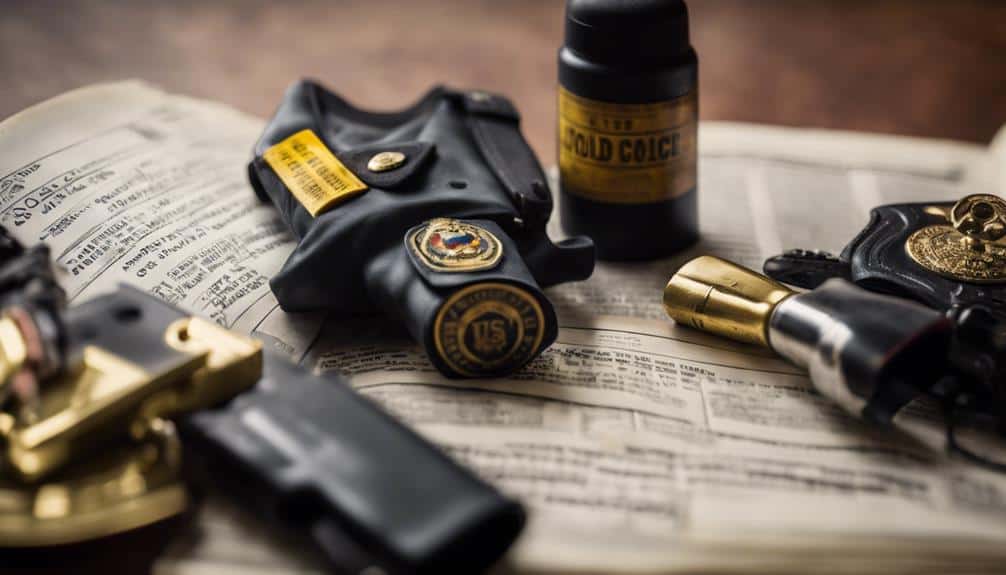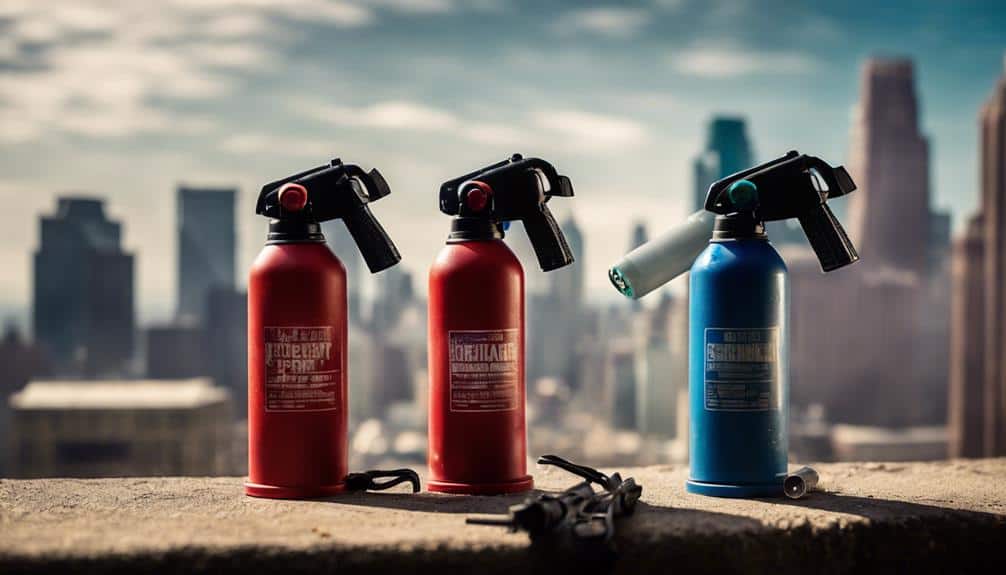Bear Spray Vs. Mace Vs. Pepper Spray: the Ultimate Showdown of Self-Defense Titans
Choosing between bear spray, mace, and pepper spray feels like entering a self-defense showdown. Bear spray creates a wide, dispersing cloud, designed to deter charging grizzlies, but it’s less effective on humans. Mace is packed with tear gas and UV dye, making it a solid choice for fending off human attackers, but might be overkill for casual self-defense. Pepper spray, derived from spicy chili peppers, offers varying concentrations and delivery methods—perfect for personal protection if local laws allow. Each has unique attributes, so your choice hinges on specific needs and environments. Stick around, and you’ll master the best pick for your safety arsenal.
 When you’re hiking in bear country, understanding how bear spray works can be a lifesaver. Bear spray is specifically designed to deter bear attacks, creating a wide cloud of spray, unlike other self-defense tools.
This formulation includes a lower concentration of oleoresin capsicum, making it effective against bears without being overly harsh. Imagine a bear lumbering towards you; with a quick spray, you can create a substantial barrier that sends the bear packing.
Bear Spray vs. other forms of self-defense sprays highlights an important distinction: bear spray isn’t ideal for human encounters. While it’s great for creating a deterrent cloud for wildlife, its lower concentration of active ingredients means it’s not as effective on humans.
You might think of it as a specialized tool in your hiking kit, much like a compass—perfect for its intended purpose but not much else.
Moreover, legal regulations often allow bear spray in places where pepper spray might be restricted. Responsible hikers and campers always carry bear spray as a precaution.
Picture yourself on a serene mountain trail, bear spray clipped to your belt, ready to guarantee your adventure remains a safe and memorable experience.
When you’re hiking in bear country, understanding how bear spray works can be a lifesaver. Bear spray is specifically designed to deter bear attacks, creating a wide cloud of spray, unlike other self-defense tools.
This formulation includes a lower concentration of oleoresin capsicum, making it effective against bears without being overly harsh. Imagine a bear lumbering towards you; with a quick spray, you can create a substantial barrier that sends the bear packing.
Bear Spray vs. other forms of self-defense sprays highlights an important distinction: bear spray isn’t ideal for human encounters. While it’s great for creating a deterrent cloud for wildlife, its lower concentration of active ingredients means it’s not as effective on humans.
You might think of it as a specialized tool in your hiking kit, much like a compass—perfect for its intended purpose but not much else.
Moreover, legal regulations often allow bear spray in places where pepper spray might be restricted. Responsible hikers and campers always carry bear spray as a precaution.
Picture yourself on a serene mountain trail, bear spray clipped to your belt, ready to guarantee your adventure remains a safe and memorable experience.
 Let’s talk about pepper spray—this compact self-defense tool packs a punch with its potent formula, perfect for warding off human attackers.
You’ll find it comes in various forms like streamers and foggers, each with its own effective deployment strategies to maximize your safety.
Plus, understanding its composition and legal usage guidelines is vital, so you can carry and use it confidently and lawfully.
Let’s talk about pepper spray—this compact self-defense tool packs a punch with its potent formula, perfect for warding off human attackers.
You’ll find it comes in various forms like streamers and foggers, each with its own effective deployment strategies to maximize your safety.
Plus, understanding its composition and legal usage guidelines is vital, so you can carry and use it confidently and lawfully.
Stay informed and always double-check your local laws to stay on the right side of the law while keeping yourself safe!
 Before you decide to carry bear spray, mace, or pepper spray, it’s important to understand the legal considerations surrounding their use. Navigating the maze of regulations can be challenging, but fear not, we’ve you covered.
Bear spray, primarily designed for wildlife, is regulated by the EPA. That means you can’t simply use it on humans without potentially facing legal consequences.
Mace, often mistaken for pepper spray, might contain tear gas or UV dye, adding another layer of complexity. Pepper spray, on the other hand, is generally permissible for self-defense against humans in most states, but local laws can vary in terms of size and concentration.
Here are three key legal points you need to know:
Before you decide to carry bear spray, mace, or pepper spray, it’s important to understand the legal considerations surrounding their use. Navigating the maze of regulations can be challenging, but fear not, we’ve you covered.
Bear spray, primarily designed for wildlife, is regulated by the EPA. That means you can’t simply use it on humans without potentially facing legal consequences.
Mace, often mistaken for pepper spray, might contain tear gas or UV dye, adding another layer of complexity. Pepper spray, on the other hand, is generally permissible for self-defense against humans in most states, but local laws can vary in terms of size and concentration.
Here are three key legal points you need to know:
Stay safe and be prepared!
 Choosing the right spray involves evaluating your specific needs and environment. Whether you’re hiking through bear country or maneuvering urban streets, each type of spray serves a distinct purpose. Let’s break it down to make your decision easier.
Choosing the right spray involves evaluating your specific needs and environment. Whether you’re hiking through bear country or maneuvering urban streets, each type of spray serves a distinct purpose. Let’s break it down to make your decision easier.
Understanding Bear Spray

All About Mace
When it comes to Mace, you’ve got a powerhouse of self-defense options at your fingertips, blending tear gas, UV dye, or both to stop attackers in their tracks. It’s designed to irritate the eyes, skin, and respiratory system, giving you an essential window to escape safely. Whether you choose the spray, gel, or foam, Mace offers a versatile and non-lethal way to protect yourself without resorting to physical force.Composition and Ingredients
Mace, primarily composed of phenacyl chloride (CN tear gas), is a powerful irritant designed to incapacitate attackers through temporary blindness, respiratory distress, and intense pain. Unlike bear spray, which is formulated specifically to deter aggressive wildlife, Mace is tailored for human attackers, making it a go-to for personal defense. Think of it as your portable superhero sidekick—minus the cape. You might be wondering, what makes Mace so effective? Its active ingredient, phenacyl chloride, has been used in various formulations for law enforcement as well as personal defense. When released, it forms an aerosol mist that targets an attacker’s eyes and respiratory system, causing immediate discomfort. The result? An incapacitated assailant, giving you precious time to escape. Different formulations of Mace exist for various needs. For instance, law enforcement versions may include additional compounds to enhance effectiveness. Be aware, though, that Mace is regulated in some states, so always check local laws before making it your defense tool of choice.Usage and Effectiveness
For self-defense, Mace pepper spray stands out due to its ability to incapacitate attackers quickly and effectively. Unlike bear spray, which is designed for deterring large animals, Mace pepper spray is tailored for human threats, making it a go-to for personal protection. When you deploy Mace, you’re releasing oleoresin capsicum (OC), a potent chili pepper extract, capable of causing temporary blindness, respiratory distress, and an intense burning sensation. Imagine someone splashing hot sauce directly into your eyes—only worse. Mace isn’t just for civilians. Law enforcement agencies and security personnel rely on it to subdue aggressive individuals without resorting to lethal force. It’s the perfect blend of power and portability, fitting easily into your pocket or purse, ready to deploy at a moment’s notice. When faced with an attacker, a quick spray of Mace can buy you precious seconds to escape, call for help, or gain the upper hand. Its effectiveness at close range makes it an indispensable self-defense tool in urban settings.Pepper Spray Insights

Pepper Spray Composition
Pepper spray, a powerful self-defense tool, contains capsaicinoids derived from chili peppers, with concentrations ranging from 0.18% to 1.4%. These capsaicinoids are the active ingredients in oleoresin capsicum, giving pepper spray its fiery kick. When you use pepper spray, you’re wielding the concentrated power of chili peppers to deter a threat. The heat rating of pepper spray is measured in Scoville Heat Units (SHU), where higher SHU values mean more intense potency. When someone gets hit with pepper spray, they experience immediate pain, temporary blindness, and respiratory distress. It’s like getting a face full of the world’s spiciest chili pepper—except worse! This makes it an effective tool for self-defense in a variety of situations. Pepper spray comes in different forms such as stream, fog, or foam, each tailored for specific scenarios. Here are three key points to remember:- Oleoresin Capsicum: The active ingredient that makes pepper spray so potent.
- Variety in Forms: Available in stream, fog, and foam for different defensive needs.
- SHU Measurement: The potency is measured in Scoville Heat Units, ensuring you know exactly how hot your spray is.
Legal Usage Guidelines
Finding your way through the legal terrain for carrying and using pepper spray is essential to guarantee you’re compliant with local regulations. Let’s break down how pepper sprays are legally managed so you can be safe and smart about your self-defense choices. In most states, carrying pepper spray for self-defense is legal, but the specifics can get tricky. For instance, California restricts the size of pepper spray containers to 2.5 ounces. New York has its own set of rules, requiring you to buy pepper sprays from a licensed firearms dealer or a pharmacist. Understanding these nuances is critical to avoid legal hiccups. You might not think of pepper sprays as weapons, but some jurisdictions do. This can affect how you’re allowed to carry and use them. Always check local laws because what’s legal in one state might be a big no-no in another. Here’s a quick overview to help:| State | Key Regulation | Emotion Evoked |
|---|---|---|
| California | Max container size: 2.5 ounces | Relief knowing the limit |
| New York | Must purchase from licensed dealer/pharmacist | Frustration at restrictions |
| Texas | No major restrictions, but must be for self-defense | Confidence in protection |
| Massachusetts | Requires a firearms identification card (FID) | Annoyance at extra steps |
| Florida | Legal to carry for self-defense, no specific size limit | Assurance of safety options |
Effective Deployment Strategies
Now that you’re aware of the legal guidelines, understanding how to effectively deploy pepper spray can significantly enhance your self-defense capabilities. First and foremost, aim for the attacker’s face, specifically targeting the eyes and nose. This will optimize the pepper spray’s effectiveness, causing temporary blindness, an intense burning sensation, and difficulty breathing. It’s like hitting the bullseye in darts, but with a lot more at stake! To make sure you’re quick on the draw, practice deploying the spray regularly. Muscle memory is your best ally in high-stress situations, much like how a cowboy always knows where their gun is. Also, be mindful of wind direction—spraying into the wind can backfire, literally! Here’s a quick rundown to confirm you’re ready:- Target Practice: Aim for the face, especially the eyes and nose, for maximum impact.
- Rehearsal: Regular practice builds muscle memory and guarantees quick reaction times.
- Wind Check: Always consider wind direction before deploying to avoid self-contamination.
Effectiveness and Usage
When evaluating the effectiveness and usage of bear spray versus mace versus pepper spray, it’s important to take into account the specific threat you’re addressing. Bear spray is a lifesaver when you’re hiking in bear country. Its wide cloud dispersal is designed to create a barrier between you and a charging bear, giving you a chance to escape. Think of it as a bear’s worst nightmare in a can! However, its lower concentration of oleoresin capsicum means it’s not as effective against human threats. Pepper spray, on the other hand, is your go-to for self-defense against human attackers. With a targeted stream that can reach up to 30 feet, it doesn’t just stop an attacker—it incapacitates them, giving you time to get to safety. Imagine a would-be mugger getting a face full of fiery pepper mist; they’re not going anywhere fast! Mace is similar to pepper spray but often includes tear gas and UV dye. It’s great for self-defense but could be overkill for everyday use. When deciding which to carry, consider your environment and the kind of threats you’re most likely to face. There’s no one-size-fits-all solution, but with the right spray, you’ll be ready for anything.Legal Considerations

- Local Laws: Always check your local laws on self-defense sprays. Some states have specific regulations on the size and concentration of pepper spray you can carry.
- Usage Restrictions: Improper use of bear spray, mace, or pepper spray, such as using them in non-emergency situations, can result in legal trouble.
- Purpose: Bear spray is meant for deterring wildlife, not humans. Using it incorrectly can’t only be risky but also unlawful.
Safety and Precautions
Understanding the legal landscape is essential, but making sure you’re using bear spray, mace, or pepper spray safely is just as vital. Wind direction is crucial when deploying bear spray; otherwise, you might end up incapacitating yourself instead of the threat. Always test pepper spray in a controlled environment, so you know what to expect during a real encounter. Trust me, you don’t want any surprises when you’re in a pinch. Bear in mind, pepper spray can cause immediate swelling, mucus buildup, and breathing issues upon contact. While this might sound like a scene from a horror movie, it’s designed to give you valuable time to escape. But not everyone reacts the same way; some folks might have higher tolerances due to medication or natural resistance. When it comes to expired or unused bear spray, don’t just toss it in the trash. Proper disposal is vital to prevent accidental exposure. A mishap like that would definitely ruin your day. Here’s a handy table summarizing these precautions:| Situation | Precaution | Reason |
|---|---|---|
| Wind Direction | Check before using bear spray | Ensures effectiveness and personal safety |
| Testing | Test pepper spray in a controlled area | Familiarizes you with the spray’s effects |
| Contact Effects | Be aware of immediate reactions | Helps you prepare for potential side effects |
| Disposal | Follow proper disposal methods | Prevents accidental exposure |
Choosing the Right Spray

- Intended Use: Bear spray is specifically designed for deterring bear attacks, creating a wide cloud that can cover a larger area. On the other hand, pepper spray is ideal for self-defense against humans, releasing a targeted stream to halt an attacker in their tracks.
- Local Regulations: Check your local laws because bear spray might be legal in areas where pepper spray isn’t. This can be a game-changer, especially if you’re planning to carry it in public spaces.
- Range and Coverage: Bear spray has a wider range and disperses in a cloud, making it perfect for outdoor adventures. Pepper spray shoots a more concentrated stream, which is more suitable for close-range encounters in urban settings.
Frequently Asked Questions
Is Bear Spray Better Than Pepper Spray for Self-Defense?
When making an effectiveness comparison for self-defense, pepper spray is better than bear spray. Bear spray disperses widely, while pepper spray targets human attackers more precisely, incapacitating them quickly. Also, consider legal restrictions in your area.Is It Legal to Use Bear Spray on Humans in Self-Defense?
Using bear spray on humans in self-defense has serious legal implications. It’s specifically for wildlife, and misuse can lead to criminal charges. Stick to products designed for human self-defense to avoid legal trouble.What Percentage of Bear Spray Is Oc?
Bear spray typically has an OC concentration of 1-2%. You’ll find this lower percentage effective for deterring bears while minimizing harm, making it a responsible choice for wildlife encounters. Always check the label for accurate details.Will Bear Spray Work on Humans?
Bear spray’s effectiveness on humans is limited. It’s designed for deterring bears, not human attackers, and won’t incapacitate as well as pepper spray or mace. As a result, using bear spray for self-defense against humans isn’t recommended.
Facebook
Twitter
LinkedIn
Pinterest
Tagged Bear Spray, OC Spray, Pepper Spray, Tear Gas


14 Responses